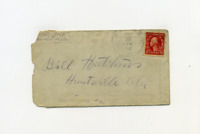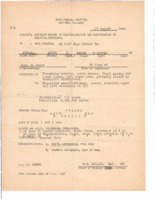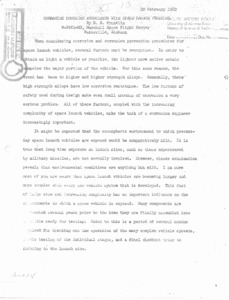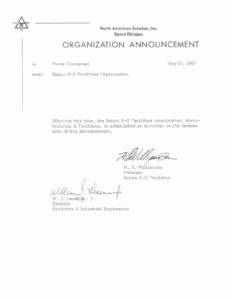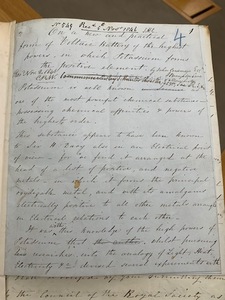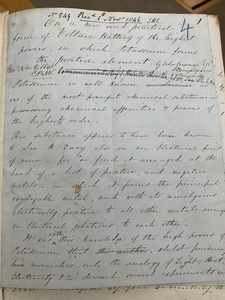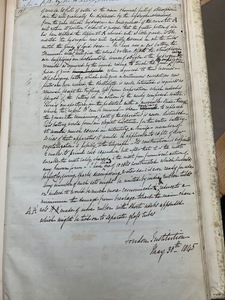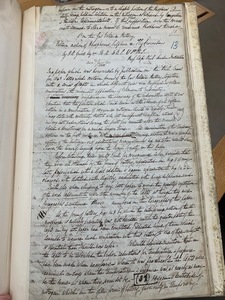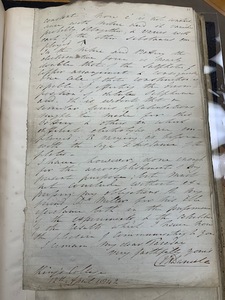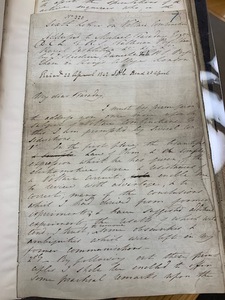
Browse Items (8239 total)
Sort by:
-
Letter to William Thomas Hutchens from Mr. Charlie Willmore.
Willmore writes that he had lived with grandmother Casey who left a will and mortgaged property to him. He states that he will "make it right with you" if Hutchens investigates and helps him get his estate left to him. -
"Abstract Record of Hospitalization and Notification of Hospital Discharge" for Edwin D. Burwell Jr.
The document notes Edwin D. Burwell Jr.'s personal information, date of admission, diagnoses, operations, and recommendations for assignment. -
"Corrosion problems associated with the Saturn space vehicles."
Corrosion problems associated with space vehicles, in general, are discussed as contrasted to those problems experienced with structures in an earth atmosphere. Primary emphasis is placed on structural alloys in this discussion, although some corrosion failures experienced in various mechanical components are described. General corrosion prevention measures are indicated, and solutions to specific corrosion failures described. Major failures experienced have been attributed to stress corrosion cracking, rather than general or galvanic type corrosion. Most such failures have occurred with only five different materials: three aluminum alloys - 7075-T6, 7079-T6, and 2024-T6; and two precipitation hardening stainless steels - 17-7PH and AM 355. Corrective actions were different in each case, but involved either a complete change to another material, a change to a different temper of the same alloy, or a modification of the heat treatment and/or general processing techniques. General conclusions are that the types of failures described could be avoided by: a more suitable selection of alloys in the initial design, a realistic review of the environments that could be encountered in the service lifetime of the component, lowering stresses, improving process controls, and effecting better familiarization of design personnel with the with the overall stress corrosion problem in an effort to reduce human error.; Preprint 18e.; Materials for re-entry and spacecraft systems - spacecraft materials.; Materials Conference, Philadelphia, Pennsylvania, March 31 - April 4, 1968. -
"Saturn S-II facilities organization."
Organizational chart for the Saturn II facilities. -
A picture of the unpublished manuscript “On a new and practical form of voltaic battery of the highest powers, in which potassium forms the positive element” (last page)
This manuscript was created by John Goodman in 1846-7. The paper goes over the creation of potassium in a unique battery arrangement consisting of sulfuric acid, platinum, crude oil, potassium, and copper wire. The author finds that the battery is able to produce current but is unable to get rid of the batteries instability. -
A picture of the unpublished manuscript “On a new and practical form of voltaic battery of the highest powers, in which potassium forms the positive element” (first page)
This manuscript was created by John Goodman in 1846-7. The paper goes over the creation of potassium in a unique battery arrangement consisting of sulfuric acid, platinum, crude oil, potassium, and copper wire. The author finds that the battery is able to produce current but is unable to get rid of the batteries instability. -
A picture of the unpublished manuscript, "On the gas voltaic battery. Voltaic action of phosphorus, sulphur, and hydrocarbons" (last page)
This resource was created by William Robert Grove in 1845. The paper goes over the various experiments of variations of the gas battery that grove made in 1842. The paper finds that non-conducting metals can be used to create electricity. -
A picture of the unpublished manuscript, "On the gas voltaic battery. Voltaic action of phosphorus, sulphur, and hydrocarbons" (first page)
This resource was created by William Robert Grove in 1845. The paper goes over the various experiments of variations of the gas battery that grove made in 1842. The paper finds that non-conducting metals can be used to create electricity. -
Picture of "The sixth letter from John Frederic Daniell to Michael Faraday" on the constant battery (last page)
This picture is the last page of the sixth letter to Michael Faraday from John Frederic Daniell. The first page goes over summarizes the content of the letter, asks further questions, and gives good tidings. The content being on the progress of applying ohm's law to the Daniell Cell or constant battery. -
Picture of "The sixth letter from John Frederic Daniell to Michael Faraday" on the constant battery (first page)
This picture is the first page of the sixth letter to Michael Faraday from John Frederic Daniell. The first page goes over greetings and summarizes the past letters contents and how that relates to what he will talk about now. The rest of the paper goes on to make progress of applying ohm's law to the Daniell Cell or constant battery.
